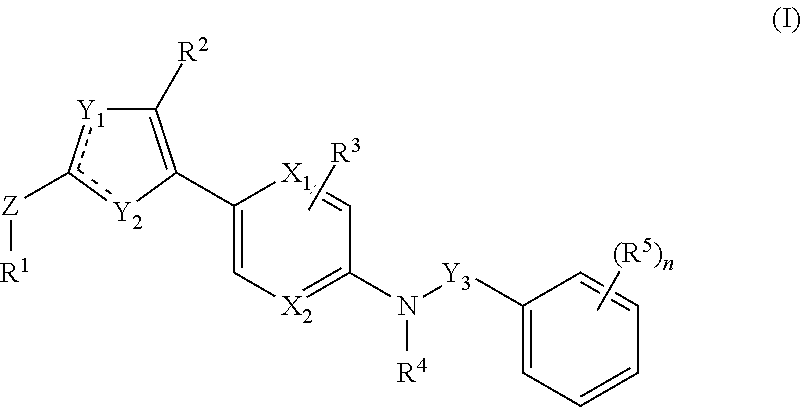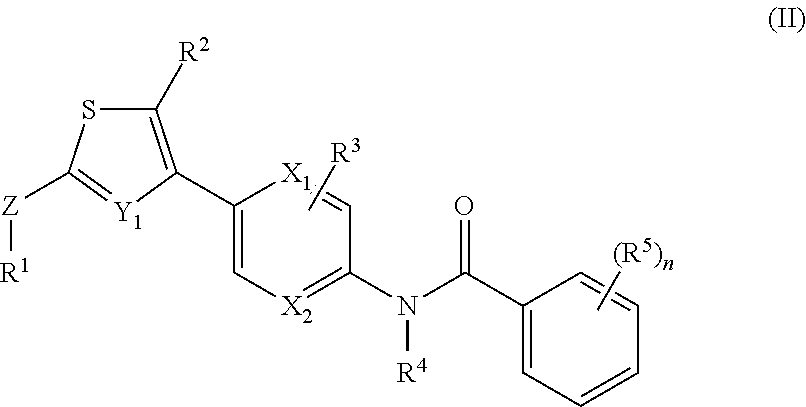Compounds for inflammation and immune-related uses
a technology of compounds and immune-related uses, applied in the field of biologically active chemical compounds, can solve the problems of inert antigenic stimulation, tissue damage, and agents that inhibit il-2 production, and achieve the effects of reducing side effects, reducing side effects, and reducing the amount of ion channel
- Summary
- Abstract
- Description
- Claims
- Application Information
AI Technical Summary
Benefits of technology
Problems solved by technology
Method used
Image
Examples
specific embodiments
[0120]The invention relates to compounds and pharmaceutical compositions that are particularly useful for immunosuppression or to treat or prevent inflammatory conditions, immune disorders, and allergic disorders. Embodiments of the invention include those compounds described hereinabove in the Summary, e.g., those of formulae (I), (II) and (III).
[0121]All of the features, specific embodiments and particular substituents disclosed herein may be combined in any combination. Each feature, embodiment or substituent disclosed in this specification may be replaced by an alternative feature, embodiment or substituent serving the same, equivalent, or similar purpose. In the case of chemical compounds, specific values for variables (e.g., values shown in the exemplary compounds disclosed herein) in any chemical formula disclosed herein can be combined in any combination resulting in a stable structure. Furthermore, specific values (whether preferred or not) for substituents in one type of c...
example 1
Synthesis of Representative Exemplary Compounds of this Invention
[0170]General Procedure for Suzuki cross coupling: To a solution of [N-(3-bromo-4-methylphenyl)pyridin-2-amine] (95 mg, 0.36 mmol), dichloro-bis (triphenylphosphine)-palladium (II) (Pd(PPh3)2Cl2, 60 mg, 0.09 mmol), and 2,6-difluoro-N-(4-(4,4,5,5-tetramethyl-1,3,2-dioxaborolan-2-yl)phenyl)benzamide (195 mg, 0.54 mmol) in toluene (10 mL) were added Na2CO3 (2 N, 1.0 mL) and ethanol (1.0 mL). The stirred mixture was heated at 80° C. for 16 hr. The solution was cooled to room temperature and diluted with H2O (10 mL) and EtOAc (10 mL). The organic phase was dried over Na2SO4, concentrated, and chromatographed to give the pure product in 61% yield.
2,6-Difluoro-N-(5-(5-methyl-2-(pyridin-2-yl)thiazol-4-yl)pyridin-2-yl)benzamide
[0171]
[0172]To the solution of 1 (1 g, 6.57 mmol) in DCM (50 mL) were added 2,6-difluorobenzoyl chloride (1.73 mL, 13.8 mmol) and pyridine (3.56 mL, 12.5 mmol) at room temperature. After stirring for 60 m...
example 2
Inhibition of IL-2 Production
[0214]Jurkat cells were placed in a 96 well plate (0.5 million cells per well in 1% FBS medium), and then a test compound of this invention was added at different concentrations. After 10 minutes, the cells were activated with PHA (final concentration 2.5 μg / mL) and incubated for 20 hours at 37° C. under 5% CO2. The final volume was 200 μL. Following incubation, the cells were centrifuged, and the supernatants collected and stored at −70° C. prior to assaying for IL-2 production. A commercial ELISA kit (IL-2 Eli-pair, Diaclone Research, Besancon, France) was used to detect production of IL-2, from which dose response curves were obtained. The IC50 value was calculated as the concentration at which 50% of maximum IL-2 production after stimulation was inhibited versus a non-stimulation control.
[0215]Inhibition of other cytokines, such as IL-4, IL-5, IL-13, GM-CSF, TNFα, and IFN-γ, can be tested in a similar manner using a commercially available ELISA kit f...
PUM
| Property | Measurement | Unit |
|---|---|---|
| temperature | aaaaa | aaaaa |
| weight percent | aaaaa | aaaaa |
| weight percent | aaaaa | aaaaa |
Abstract
Description
Claims
Application Information
 Login to View More
Login to View More - R&D
- Intellectual Property
- Life Sciences
- Materials
- Tech Scout
- Unparalleled Data Quality
- Higher Quality Content
- 60% Fewer Hallucinations
Browse by: Latest US Patents, China's latest patents, Technical Efficacy Thesaurus, Application Domain, Technology Topic, Popular Technical Reports.
© 2025 PatSnap. All rights reserved.Legal|Privacy policy|Modern Slavery Act Transparency Statement|Sitemap|About US| Contact US: help@patsnap.com



